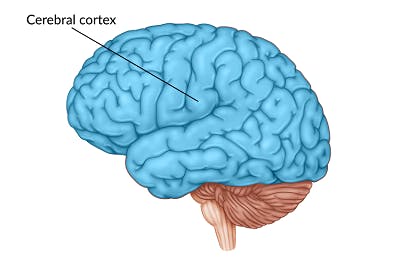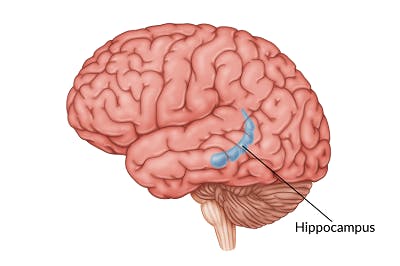Traumatic brain injury survivors may experience a range of secondary effects depending on which areas of the brain sustain damage. The parts of the brain impacted by TBI are responsible for varying functions. When areas of the brain most vulnerable during a traumatic brain injury become damaged, the brain may no longer be able to complete these functions accurately.
This article will include an overview of the most common types of TBI. It will also describe potential effects of damage to many of the areas of the brain most vulnerable during a traumatic brain injury.
Use the links below to jump straight to any section:
- Cerebral cortex
- Frontal lobe
- Hippocampus
- Basal ganglia
- Diencephalon
- Cerebellum
- Corpus callosum
- Brainstem
- Types of TBI
Areas of the Brain Most Vulnerable During a Traumatic Brain Injury
A traumatic brain injury can be defined as “an alteration in brain function, or other evidence of brain pathology, caused by an external force.”
There are many parts of the brain that can be impacted by TBI. The following list includes many of the most vulnerable areas of the brain, along with potential effects of TBI in each structure.
Cerebral Cortex TBI

As the outermost portion of the brain, the cerebral cortex is one of the most common parts of the brain impacted by TBI. The cerebral cortex is essential for more advanced functions, including thought processes, reasoning, language, emotions, behaviors, movements and sensations. Of the four main sections of the cerebral cortex, the frontal lobe tends to be affected most frequently by traumatic brain injury.
Learn more about TBI of the cerebral cortex
Frontal Lobe

The frontal lobe of the brain is responsible for higher-level cognitive functions, as well as voluntary movements. Functions affected by a TBI in the frontal lobe include concentration, problem solving skills, judgement, expressive language, and emotional regulation. Furthermore, if the TBI affects the primary motor cortex within the frontal lobe, movement of the body opposite the side of the brain damage may be affected.
Learn more about TBI of the frontal lobe
Hippocampus

The hippocampus is the area of the brain responsible for memory. When it is damaged during a traumatic brain injury, individuals often have difficulties with making new memories, as well as retrieving old ones. Blast injuries frequently result in damage to the hippocampus.
Learn more about TBI of the hippocampus
Basal Ganglia

The basal ganglia are responsible primarily for motor control. When this part of the brain is impacted by TBI, motor disorders resulting in irregular movement patterns may occur. Furthermore, damage to a portion of the basal ganglia called the caudate nucleus frequently results in cognitive fatigue.
Learn more about TBI of the basal ganglia
Diencephalon

The diencephalon consists of many structures, including the thalamus and hypothalamus. The thalamus may be involved in many mild TBIs, resulting in problems such as headache, insomnia, fatigue, and cognitive difficulties. Diffuse axonal injuries, a type of TBI, often involve hypothalamus damage, causing changes in endocrine functions. This can result in effects such as extreme variations in body temperature, hypothyroidism, and diabetes.
Learn more about TBI of the thalamus
Learn more about TBI of the hypothalamus
Cerebellum

The cerebellum is responsible for coordinating motor movements. Since the cerebellum is sensitive to oxygen deprivation, it is commonly damaged during global anoxic brain injuries, a type of TBI where the brain is deprived of oxygen. Damage to the cerebellum may result in challenges with motor coordination (apraxia) and balance, as well as changes in language and cognition.
Learn more about TBI of the cerebellum
Corpus Callosum

The corpus callosum is a group of nerve fibers which connect the left and right hemispheres of the brain. It is frequently damaged following concussion (mild TBI) and diffuse axonal injury. Damage to the corpus callosum impedes the ability of the two hemispheres to communicate. Effects of corpus callosum damage include cognitive deficits, impaired working memory, trouble with tasks involving both sides of the body and the development of alien hand syndrome (where one hand moves on its own outside of conscious control).
Learn more about TBI of the corpus callosum
Brainstem

Brainstem damage may occur during diffuse axonal injury. The brainstem is responsible for basic life functions, such as breathing and maintaining your heart rate. Therefore, when this part of the brain is impacted by TBI, the effects are often severe. These effects include changes in consciousness (often resulting in a coma initially after the brain injury) and difficulties with breathing and swallowing. Individuals with brainstem damage often require around 2 months to regain consciousness, but can still have positive recovery outcomes.
Learn more about TBI of the brainstem
Understanding the Different Types of TBI
The effects of a TBI are not only influenced by the area of the brain affected, but also by the type of TBI the survivor sustained. There are a variety of factors to consider when further classifying types of TBI, including:
Mild, Moderate, and Severe TBI
A mild traumatic brain injury, or concussion, occurs when the brain sustains mild impact and symptoms generally resolve on their own. A moderate TBI involves more impact and often results in more long-term effects than a concussion. Finally, a severe TBI often affects multiple areas of the brain and results in many long-term effects that require long-term rehabilitation.
Doctors often use the Glasgow Coma Scale, which involves examining a survivor’s responses to stimulation, to determine the severity of a traumatic brain injury.
Penetrating TBI vs. Closed Brain Injury
A penetrating traumatic brain injury refers to when the brain is damaged by an object entering through the skull, such as a bullet. These are less common, but generally more severe, than a closed brain injury, which refers to brain damage caused by rapid movement of the brain within the skull.
Focal TBI, Diffuse Axonal Injury, and Global Anoxic Brain Injury
Focal traumatic brain injury occurs when damage is confined to one specific area of the brain. Conversely, there are generally multiple parts of the brain impacted by TBI when a diffuse axonal injury has occurred. Diffuse axonal injury refers to the tearing of long, connecting portions of brain cells (called axons) due to the rapid movement of the brain. Global anoxic brain injuries, which are caused by a lack of oxygen in the brain, are often severe and may also affect multiple brain structures.
Coup-Contrecoup Injury
A coup-contrecoup injury refers to a type of focal closed brain injury caused by the brain hitting the inside of the skull. A coup injury occurs when the brain is damaged directly under the point of impact, while a contrecoup injury occurs when the brain is damaged opposite from the point of impact. These injuries may occur separately or during the same incident.
Blast Injury
A blast injury refers to brain damage caused by explosions. Commonly seen in members of the military, blast injuries may be classified in four ways:
- Primary: occurs when shock waves cause pressure changes in the brain
- Secondary: caused by the impact of flying debris
- Tertiary: results when an individual is thrown from the blast
- Quaternary: any other explosion-related injury
Of note, primary blast injuries can occur without any direct contact with an object, and frequently result in mild traumatic brain injuries.
Understanding Traumatic Brain Injury Locations
Every TBI is unique and therefore every TBI recovery process is also unique. Understanding the size and location of a traumatic brain injury is the first step towards understanding the aftermath and the best way to pursue rehabilitation.
The areas of the brain most vulnerable during a traumatic brain injury differ depending on which type of TBI is sustained. Consider talking with your neurologist about which parts of the brain were impacted by your TBI, as it could help you and your loved ones know what types of effects to expect.
While recovery after traumatic brain injury varies person to person, it is beneficial to pursue therapy on a consistent basis. Through therapy, you can receive personalized treatment related to the specific parts of the brain impacted by TBI for an optimal recovery.










